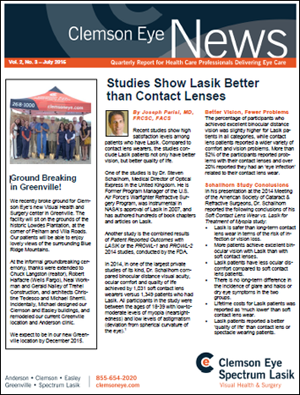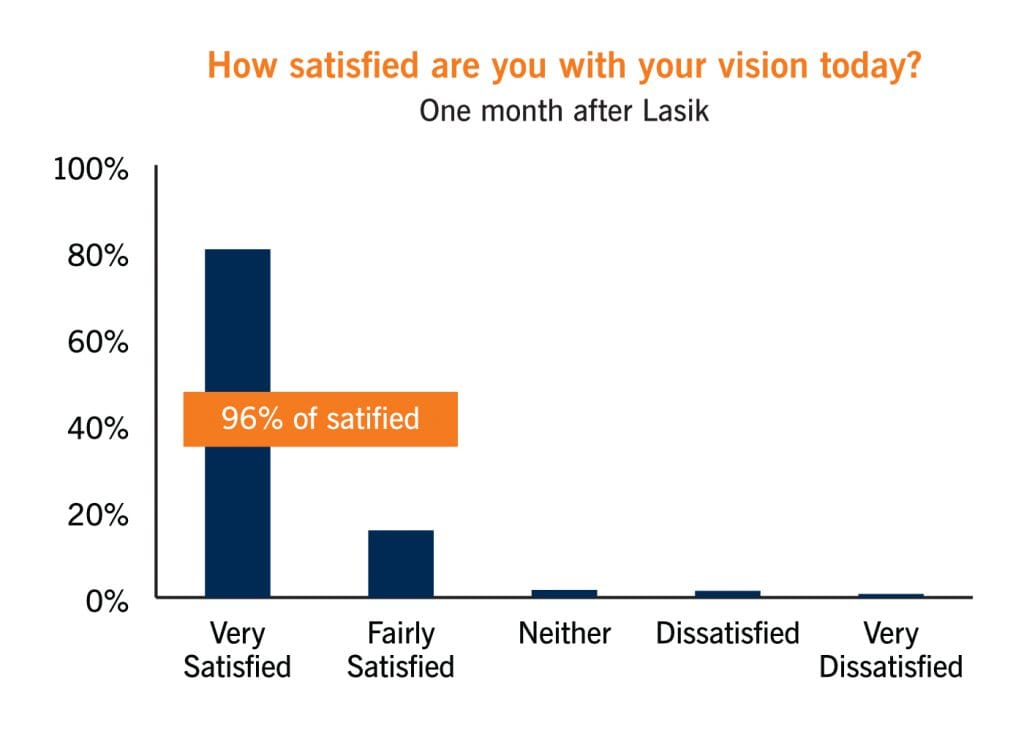Posted by: Clemson Eye in News

By Dr. Joseph Parisi
Clemson Eye News, July 2015
Recent studies show high satisfaction levels among patients who have Lasik. Compared to contact lens wearers, the studies conclude Lasik patients not only have better vision, but better quality of life.
One of the studies is by Dr. Steven Schallhorn, Medical Director of Optical Express in the United Kingdom. He is Former Program Manager of the U.S. Air Force’s Warfighter Refractive Surgery Program, was instrumental in NASA’s approval of Lasik in 2007, and has authored hundreds of book chapters and articles on Lasik.
Another study is the combined results of Patient Reported Outcomes with LASIK or the PROWL-1 and PROWL-2 2014 studies, conducted by the FDA.
In 2014, in one of the largest private studies of its kind, Dr. Schallhorn compared binocular distance visual acuity, ocular comfort and quality of life achieved by 1,031 soft contact lens wearers versus 1,349 patients who had Lasik. All participants in the study were between the ages of 18-39 with low-to-moderate levels of myopia (nearsightedness) and low levels of astigmatism (deviation from spherical curvature of the eye).1
Better Vision, Fewer Problems
The percentage of participants who achieved excellent binocular distance vision was slightly higher for Lasik patients in all categories, while contact lens patients reported a wider variety of comfort and vision problems. More than 52% of the participants reported problems with their contact lenses and over 20% reported they had an ‘eye infection’ related to their contact lens wear.
Schallhorn Study Conclusions
In his presentation at the 2014 Meeting of the American Society of Cataract & Refractive Surgeons, Dr. Schallhorn reported the following conclusions of his Soft Contact Lens Wear vs. Lasik for Treatment of Myopia study:
- Lasik is safer than long-term contact lens wear in terms of the risk of infection or vision loss.
- More patients achieve excellent binocular vision with Lasik than with soft contact lenses.
- Lasik patients have less ocular discomfort compared to soft contact lens patients.
- There is no long-term difference in the incidence of glare and halos or dry eye symptoms in the two groups.
- Lifetime costs for Lasik patients
was reported as ‘much lower’ than soft contact lens wear. - Lasik patients reported a better ‘quality of life’ than
contact lens orspectacle wearing patients.

Schallhorn and FDA PROWL studies all reported 96% satisfaction levels for Lasik patients.
FDA Confirms Higher Satisfaction with Lasik
One of the largest Lasik studies to date by the FDA was done in 2014. PROWL-1 was conducted at the Navy Refractive Surgery Center in San Diego on 224 patients2, and PROWL-2 was done publically on 260 patients3 to confirm the PROWL-1 findings in the general population. They both used online questionnaires and personal interviews.
The dissatisfaction rates among Lasik patients in all these studies were low at 4%, which matches the average enhancement rate required by Lasik patients. This rate may be lower after an enhancement. However, this was not specifically addressed in the study.
Another significant finding of the PROWL studies was that symptoms of glare, halos and night driving problems were significantly improved after Lasik.
Patient Education and Care
Over 20 years of clinical application, Lasik technique and technology have steadily improved. Today, all-laser Lasik has proven to be a highly successful procedure. The results of these important 2014 studies indicate it is safer, less expensive and enhances quality of life over long-term contact lens use.
Given these findings, it is interesting that more patients are not opting for Lasik. Part of this is likely blow back from our economic recession and its slow recovery. But it is also likely a failure of our industry to provide better education on the safety and lifestyle advantages of laser vision
correction.
Part of that education is helping patients understand the difference between advanced all-laser Lasik and traditional bladed Lasik. In study after study, the visual outcomes for patients of all-laser Lasik, the only type we perform at Clemson Eye, are significantly better than for patients who had a microkeratome (bladed flap creation) Lasik procedure.4
Some low-cost providers lure patients in with rock-bottom prices and then provide them with less successful manual surgical procedures. Or they aggressively up-sell patients to more expensive, but still bladed Lasik procedures.
Having performed Lasik for many years, using both microkeratome and then the femtosecond laser procedure, I can assure you the best visual outcomes are achieved using the most advanced techniques and technology, and in our industry that means all-laser vision correction. Please help educate your patients about the difference.
Dr. Joseph Parisi is Chief Ophthalmologist and Medical Director at Clemson Eye.
- ‘Soft Contact Lens Wear Vs. Lasik For Treatment of Myopia’ Presented: 2014 ASCRS/ASOA, Boston, Massachusetts, Steve T. Schallhorn, MD.
- Patient-Reported Outcomes with Lasik (PROWL-1) Results Elizabeth M. Hofmeister, MD CAPT, MC, USN Naval Medical Center San Diego Refractive Surgery Advisor for Navy Ophthalmology Assistant Professor of Surgery, Uniformed Services University.
- Patient Reported Outcomes with Lasik-2 (PROWL-2) Malvina B. Eydelman, M.D. Director Division of Ophthalmic and Ear, Nose and Throat Devices ODE/CDRH/FDA.
- Klin Monbl Augenheilkd. 2013 Apr; 230(4): 337-41. doi: 10.1055/s-0032-1328384. Epub 2013 Apr 29.